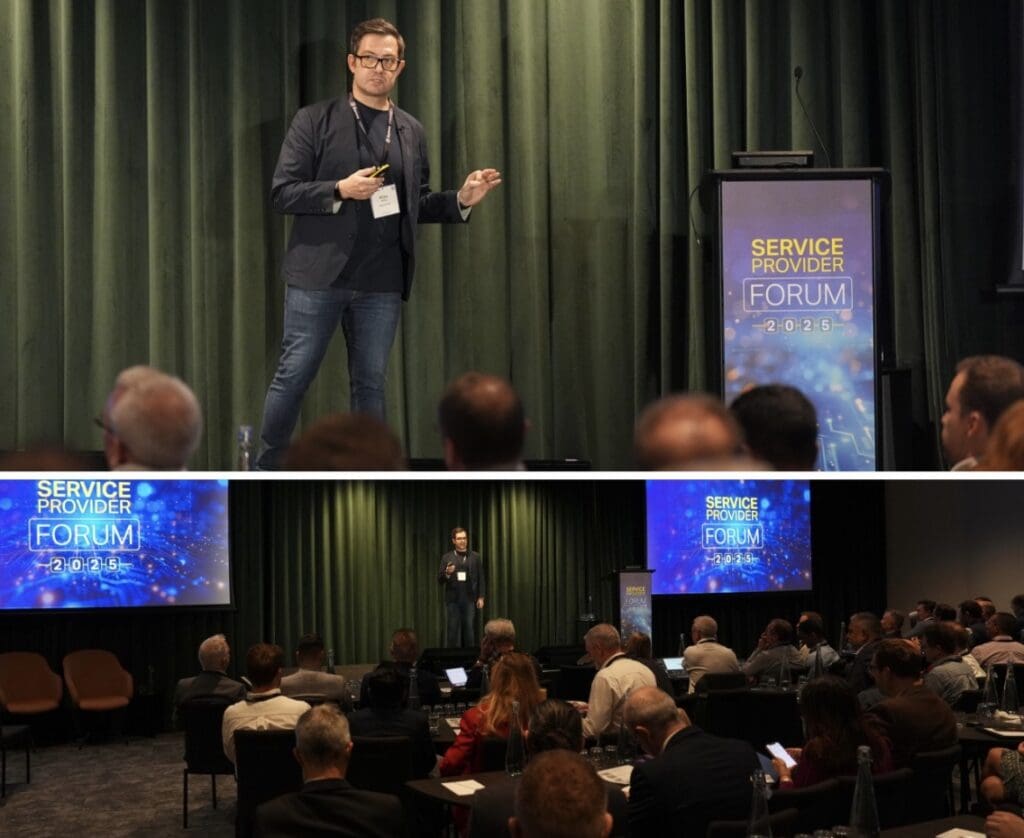Top Highlights from Gamma’s Service Provider Forum
Gamma hosted its annual Service Provider Forum this week, with globalisation underpinning a day of insightful sessions.
We’ve picked out the top takeaways from the event.
Gamma’s Strategic Direction
Gamma is positioning itself for significant global expansion while maintaining its commitment to service providers.
Service providers remain a key focus in Gamma’s five-year plan, and a “significant investment” has been dedicated to supporting service provider growth.
The company has been actively expanding its portfolio through strategic acquisitions, including EnableX (Pragma) and Coolwave, integrating these offerings into its core proposition. This expansion extends beyond the UK, with Gamma emphasising that they’re not reducing UK investment but rather enhancing their ability to offer services globally.

A particularly significant development is Gamma’s triparty agreement model for international expansion. This innovative approach allows service providers to handle customer relationships in countries outside the UK, while Gamma manages the complex regulatory aspects across those international markets. For many service providers, navigating the regulatory landscape in multiple jurisdictions has been a major barrier to global expansion.
The triparty model directly addresses this challenge by leveraging Gamma’s regulatory expertise and established international presence, enabling service providers to expand their footprint globally without having to become regulatory experts in each new market they enter.
The forum highlighted Gamma’s commitment to balancing automation with human interaction. They said that while many wholesalers are offshoring or aggressively automating processes, Gamma recognises the continued importance of personal communication. Their strategy involves enhancing automation and platforms while simultaneously increasing human resources, with 20-30 new positions in the service provider team expected in the near future.
Global Expansion Opportunities
The forum presented compelling data on international market opportunities, with Cavell’s analysis revealing significant growth potential across various regions. With over 467 million business telephony users globally—approximately 129 million in Europe, 104 million in North America, and more than 130 million in Asia—the international opportunity for service providers is substantial.
Germany emerged as a particularly promising market with relatively low cloud communications penetration but projected growth of 16-18% compound annual growth rate (CAGR) over the next five years. This represents an addition of more than 6 million users, making it one of Europe’s most attractive expansion targets. France similarly shows strong growth potential, with an expected addition of over 4 million users in the coming years.
In contrast, more mature markets like Portugal, the USA, the Netherlands, and the UK show higher current penetration rates (60-65%) but slower projected growth of 5-8% CAGR. Despite this slower growth, these markets still represent significant opportunities, with the US expected to add nearly 14 million users and the UK approximately 5 million users over the next five years.
The APAC region was highlighted as an emerging frontier, with Australia, Hong Kong, Japan, and Singapore collectively accounting for 10.7 million cloud communications users. Notably, 2.3 million of these users were added in 2024 alone, demonstrating the region’s accelerating adoption. Japan, despite its relatively low penetration compared to other APAC markets, is forecast to see the highest growth over the next five years, adding significant numbers to its current 4.5 million users.
The forum noted an interesting trend regarding European businesses showing increasing reluctance to fully commit to American public cloud platforms, potentially opening opportunities for hybrid deployments. This sentiment appears to be influenced by geopolitical factors and data sovereignty concerns, which service providers should consider when developing their international strategies.

Cavell’s survey data presented at the forum revealed that geographic expansion ranks as the second-highest investment priority for service providers, behind only product development. Already, two-thirds of surveyed providers operate in multiple markets, with an additional 4% planning international expansion within the next year.
The main drivers for international expansion identified at the forum included revenue growth opportunities in less saturated markets, market diversification to reduce dependency on single regions, risk mitigation against local economic downturns or regulatory changes, and economies of scale that can reduce cost per unit of service.
However, the forum also highlighted key considerations for successful expansion: the need for innovation and technology adaptation to meet diverse customer needs; regulatory compliance across different jurisdictions, which some service providers find so complex they’ve withdrawn from less critical markets; and cultural and operational challenges, including understanding local business practices and managing distributed workforces.
Gamma’s expanding European and international presence was positioned as a strategic advantage for service providers looking to navigate these challenges, offering both the infrastructure and regulatory expertise to support global ambitions.
Regulatory Challenges in Telecommunications
One of the most significant challenges addressed during the forum was the complex regulatory landscape facing telecommunications providers. The European Electronic Communications Code serves as a single regulatory framework across the EU and UK, but as highlighted during the sessions, each member state interprets and implements it differently.
France was cited as a prime example of regulatory variance, having initially taken a “nuclear” approach to sub-allocation through bans, though they’ve since begun rolling back some of these stringent measures. Ireland’s approach was also discussed, where their solution requires sub-allocation recipients to register with regulators and report on number usage.
A significant portion of Gamma’s work involves representing the channel and complex supply chain interests to regulators who may default to understanding only vertically integrated providers. This advocacy extends beyond just regulators to government entities and industry associations, both nationally and internationally.
Know Your Customer (KYC) and Know Your Traffic (KYT) procedures were identified as crucial elements for compliance, with an emphasis on documenting customer use cases, maintaining effective record-keeping, and monitoring traffic patterns for suspicious activity.
The MVNO Opportunity
The forum presented compelling data about the Mobile Virtual Network Operator (MVNO) market, which currently stands at $85 billion globally and is projected to grow to $155 billion by 2031. Europe represents a substantial portion of this market, currently at $35 billion, with forecasts suggesting growth to $65 billion.
The MVNO opportunity spans multiple segments within the telecommunications ecosystem. Traditional telecommunications services continue to show steady growth, while media and entertainment MVNOs are increasingly targeting digital influencers looking to monetise their following. The business services sector presents a significant opportunity as organisations seek to bring consumer-level mobile experiences to their professional users. Perhaps most promising is the machine-to-machine and IoT sector, which is expected to nearly double in growth as connected devices become ubiquitous across industries.
Several factors are driving MVNO growth in Europe, according to forum speakers. The evolution of “MVNO in a box” solutions and Mobile Virtual Network Aggregators has dramatically reduced barriers to entry, bringing setup costs down from nearly a million pounds to much more accessible levels. This democratisation of access coincides with increasingly mobile-first consumer behaviour, particularly among those born after 1985 who prioritise mobile for all communications. Consumer expectations have also shifted, with greater willingness to purchase from non-network operators and growing demand for tailored propositions that address specific needs. Industry consolidation, particularly the Vodafone-Three merger, creates additional opportunities as the combined entity will need to fill massive network capacity.
Success in the MVNO space requires several key elements, according to the forum presenters. A trusted brand forms the foundation, whether established or built from scratch. Access to customers—either through existing distribution channels or digital marketing expertise—enables market reach. Telecommunications competence ensures service quality, while differentiated propositions targeted at specific customer segments create competitive advantage. A customer-centric approach builds loyalty, and strong wholesale partnerships provide the commercial foundation necessary for profitability.
The forum highlighted four particularly promising use cases for service providers considering the MVNO space. Business mobile services that deliver consumer-like experiences represent a significant opportunity, addressing the growing demand for intuitive, digital-first business communications. Multiplay offerings for ISPs and broadband providers can increase average revenue per user by extending relationships from premises to individuals. Fixed substitution and backup solutions offer revenue opportunities with relatively low utilisation, effectively functioning as insurance policies for consumers and businesses alike. Meanwhile, machine-to-machine and IoT applications span countless industries, from agriculture to security to transportation.
IoT applications received particular attention during the discussions, with examples ranging from agricultural applications like sensor-equipped greenhouses that operate with minimal human intervention to a wide variety of business process automation opportunities. The advent of 5G technology has exponentially expanded these possibilities, enabling more devices to communicate simultaneously with lower latency.
Conclusion
The Gamma Service Provider Forum provided a comprehensive view of the telecommunications landscape, highlighting both challenges and opportunities.
For service providers, Gamma’s strategic investments and global expansion offer enhanced partnership possibilities, while the growing MVNO market presents compelling new revenue streams.
Despite regulatory complexities, the forum presented an optimistic outlook, emphasising innovation, customer-centricity, and strategic partnerships as keys to future success in an increasingly connected global market.
